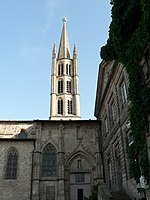Chapel of St. Aurelianus, Limoges
15th-century Roman Catholic church buildings in France15th-century establishments in France17th-century Roman Catholic church buildings in FranceBaroque church buildings in FranceBuildings and structures in Limoges ... and 5 more
Churches in Haute-VienneFrance Roman Catholic church stubsMonuments historiques of Nouvelle-AquitaineRoman Catholic chapels in FranceRoman Catholic shrines in France

The Chapel of St. Aurelianus (French: chapelle Saint-Aurélien; Occitan: chapela de Sant Aurelhan) is a 15th and 17th-century chapel that hosts the relics of Saint Aurelianus in Limoges, Haute-Vienne, France. It is an official Historic Monument.
Excerpt from the Wikipedia article Chapel of St. Aurelianus, Limoges (License: CC BY-SA 3.0, Authors, Images).Chapel of St. Aurelianus, Limoges
Rue Saint-Aurélien, Limoges Les Emailleurs
Geographical coordinates (GPS) Address Nearby Places Show on map
Geographical coordinates (GPS)
| Latitude | Longitude |
|---|---|
| N 45.828333333333 ° | E 1.2572222222222 ° |
Address
Rue Saint-Aurélien 6
87000 Limoges, Les Emailleurs
Nouvelle-Aquitaine, France
Open on Google Maps









